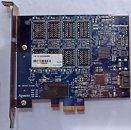- Joined
- Oct 9, 2007
- Messages
- 47,774 (7.41/day)
- Location
- Dublin, Ireland
| System Name | RBMK-1000 |
|---|---|
| Processor | AMD Ryzen 7 5700G |
| Motherboard | Gigabyte B550 AORUS Elite V2 |
| Cooling | DeepCool Gammax L240 V2 |
| Memory | 2x 16GB DDR4-3200 |
| Video Card(s) | Galax RTX 4070 Ti EX |
| Storage | Samsung 990 1TB |
| Display(s) | BenQ 1440p 60 Hz 27-inch |
| Case | Corsair Carbide 100R |
| Audio Device(s) | ASUS SupremeFX S1220A |
| Power Supply | Cooler Master MWE Gold 650W |
| Mouse | ASUS ROG Strix Impact |
| Keyboard | Gamdias Hermes E2 |
| Software | Windows 11 Pro |
Apacer is working on a hard drive cache-SSD of its own, which is similar in principle to OCZ's Revodrive Hybrid. Called PHFD, the cache-SSD is a full-height PCI-Express 2.0 x1 add-on card, which seats a Marvell 88SE9130 (or similar) 2-port SATA 6 Gb/s controller, with one port wired to an onboard 32 GB SSD subunit, and the other port given out as a standard SATA port (to which you plug your system HDD). Marvell 88SE9130 includes a feature called HyperDuo, which is similar to Intel Rapid Storage Technology (RST), it handles the SSD-caching on PFHD. Apacer's solution could end up being a cost-effective solution to systems without Intel RST.

View at TechPowerUp Main Site

View at TechPowerUp Main Site




